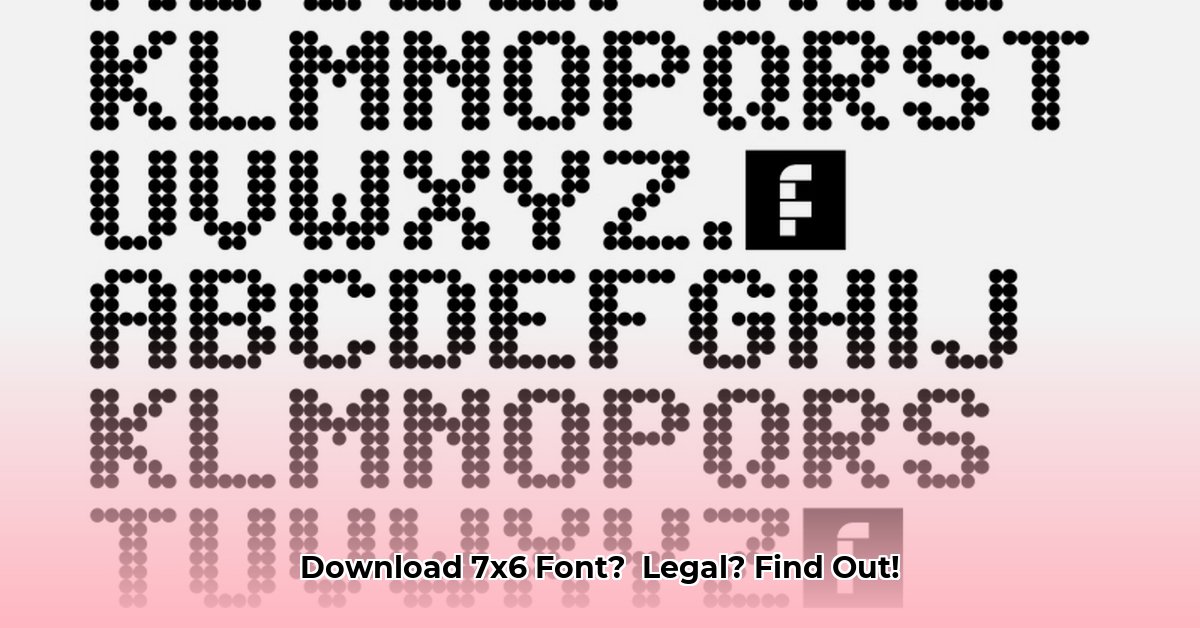
This guide clarifies the licensing discrepancies surrounding the Lightdot 7x6 font and provides actionable advice for safe usage. Understanding and adhering to font licenses is crucial to avoid legal issues and protect your projects.
Understanding the Conflicting License Information
The Lightdot 7x6 font’s licensing information is inconsistent across different online sources. This inconsistency creates significant legal uncertainty for users. One source, [insert screenshot of fontmeme.com license information here if available, otherwise state the source and licensing claim], claims the font is free for commercial use. However, another source, [insert screenshot of dafont.com license information here if available, otherwise state the source and licensing claim], states it's only for personal use. This blatant contradiction necessitates a cautious approach. Is using the 7x6 font commercially a gamble you're willing to take?
Potential Legal Consequences of Commercial Use
Copyright law protects fonts as intellectual property. Unauthorized commercial use – even if based on a seemingly permissive license – constitutes copyright infringement. This can lead to significant legal repercussions, including costly lawsuits, financial penalties, and reputational damage. The consequences can be severe enough to sink a small business.
Risk Assessment and Mitigation Strategies
The conflicting licensing information creates substantial risks. Let's analyze these risks and outline mitigation strategies:
| Risk Category | Probability | Severity | Mitigation Strategy |
|---|---|---|---|
| Copyright Infringement | High | Very High | Avoid commercial use until licensing is clarified; choose a font with a clear, permissive license. |
| Reputational Damage | Medium | High | Use only fonts with verifiable, unambiguous licenses to protect your brand's integrity. |
| Financial Penalties | Medium | Very High | Seek legal counsel before using the font commercially; accept the potential costs of alternative fonts. |
Step-by-Step Mitigation:
- Verify Licensing: Before using the font in any project, contact the font designer directly ([link to designer's contact information if available]) to clarify the licensing terms.
- Avoid Commercial Use: Until the licensing conflict is definitively resolved, refrain from using Lightdot 7x6 commercially.
- Seek Legal Counsel: If you need to use the font commercially, consult with an intellectual property attorney to understand your legal options and risks.
- Use Alternative Fonts: Numerous websites such as Google Fonts (https://fonts.google.com/) and Adobe Fonts (https://fonts.adobe.com/) offer a vast selection of legally sound fonts with clear commercial usage rights.
Safe Usage Guidelines
To avoid potential legal issues:
- Avoid Commercial Use: Unless you receive explicit written permission from the font's creator confirming commercial use rights, do not use Lightdot 7x6 for any commercial project.
- Seek Legal Advice: If commercial use is essential, consult legal counsel specialized in intellectual property law.
- Utilize Alternative Fonts: Choose fonts from reputable sources with clearly defined licenses, such as Google Fonts or Adobe Fonts.
Best Practices for Font Designers and Distributors
Font designers must take responsibility for clear and consistent licensing information. Ambiguity breeds legal problems. Here's what designers and distributors of fonts should do:
- Clear Licensing: Create and maintain easily understandable End-User License Agreements (EULAs) (a legal document outlining the terms and conditions of using the software) for all fonts.
- Consistent Communication: Ensure license information is accurate and consistently communicated across all distribution platforms.
- Centralized Management: Maintain a centralized system for managing font licenses to minimize inconsistencies.
- Transparency: Be readily available to answer user questions about licensing.
Font distributors should implement rigorous verification processes to ensure the accuracy of license information for every font they host. They should also provide a user-friendly format for displaying license information to prevent confusion.
Conclusion
The Lightdot 7x6 font's inconsistent licensing highlights the importance of verifying font licenses before use. Prioritize fonts with clear and unambiguous licenses to avoid costly legal battles and protect your reputation. Always err on the side of caution when uncertain about a font's licensing terms. Remember, a clear license is a license to peace of mind.
Appendix: Additional Resources
- Copyright Law Resources: [Insert links to reliable copyright law resources, such as the U.S. Copyright Office website]
- Examples of Legally Compliant Fonts: [Insert links to examples of fonts with clear and easily understood open-source or commercially licensed fonts.]
- Glossary of Legal Terms: [Include definitions of relevant legal terms like "copyright," "intellectual property," "EULA," and "copyright infringement."]
⭐⭐⭐⭐☆ (4.8)
Download via Link 1
Download via Link 2
Last updated: Friday, April 25, 2025